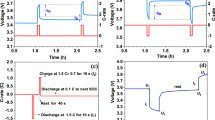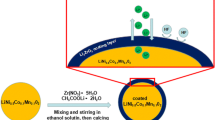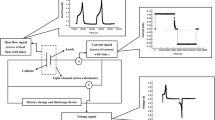Abstract
To further understand the thermal properties of lithium ion batteries, in situ measurement and calculation of the heat generation under operating condition are conducted. In this work, a novel micro-calorimeter with high accuracy is applied to study the heat flow of the LiNi0.5Co0.2Mn0.3O2/Li half cell. The dynamic heat generation and corresponding electrochemical data are detected out under isothermal environment from 30°C to 70°C with different current rates (0.2, 0.4, 0.6, 0.8 and 1.0 C) and electrode thicknesses (400, 200 and 100 μm). In addition, heat generation rate is calculated based on the measurement of entropy coefficient and internal resistance. It is found that the heat generation rises with the increase of thickness and current rate, due to concentration polarization and electrochemical polarization, respectively. The lithiation process is more sensitive to changes in current rate than delithiation. Appropriately increasing the temperature can improve the activity of material and reduce the energy consumption of the battery. Besides, the contribution of reversible heat to the overall heat generation should be taken into account especially at a lower current rate (< 0.5 C). The detailed analysis of heat generation and electrochemical performance can provide accurate data for thermal management systems.









Similar content being viewed by others
References
Wang Q, Mao B, Stoliarov SI, Sun J (2019) A review of lithium ion battery failure mechanisms and fire prevention strategies. Prog Energy Combust Sci 73:95–131
Omar N, Monem MA, Firouz Y, Salminen J, Smekens J, Hegazy O, Gaulous H, Mulder G, Van den Bossche P, Coosemans T (2014) Lithium iron phosphate based battery–assessment of the aging parameters and development of cycle life model. Appl Energy 113:1575–1585
Waag W, Käbitz S, Sauer DU (2013) Experimental investigation of the lithium-ion battery impedance characteristic at various conditions and aging states and its influence on the application. Appl Energy 102:885–897
Darcovich K, Henquin ER, Kenney B, Davidson I, Saldanha N, Beausoleil-Morrison I (2013) Higher-capacity lithium ion battery chemistries for improved residential energy storage with micro-cogeneration. Appl Energy 111:853–861
Wang Q, Ping P, Zhao X, Chu G, Sun J, Chen C (2012) Thermal runaway caused fire and explosion of lithium ion battery. J Power Sources 208:210–224
Bandhauer TM, Garimella S, Fuller TF (2011) A critical review of thermal issues in lithium-ion batteries. J Electrochem Soc 158:R1–R25
Du S, Lai Y, Ai L, Ai L, Cheng Y, Tang Y, Jia M (2017) An investigation of irreversible heat generation in lithium ion batteries based on a thermo-electrochemical coupling method. Appl Therm Eng 121:501–510
Liu X, Wu Z, Stoliarov SI, Denlinger M, Masias A, Snyder K (2016) Heat release during thermally-induced failure of a lithium ion battery: impact of cathode composition. Fire Saf J 85:10–22
Jiang F, Liu K, Wang Z, Tong X, Guo L (2018) Theoretical analysis of lithium-ion battery failure characteristics under different states of charge. Fire Mater 42:680–686
Said AO, Lee C, Liu X, Wu Z, Stoliarov SI (2019) Simultaneous measurement of multiple thermal hazards associated with a failure of prismatic lithium ion battery. Proc Combust Inst 37:4173–4180
Sun Q, Wang Q, Zhao X, Sun J, Lin Z (2015) Numerical study on lithium titanate battery thermal response under adiabatic condition. Energy Convers Manag 92:184–193
Zhu C, Li X, Song L, Xiang L (2013) Development of a theoretically based thermal model for lithium ion battery pack. J Power Sour 223:155–164
Saw L, Ye Y, Tay A (2013) Electrochemical–thermal analysis of 18650 lithium iron phosphate cell. Energy Convers Manag 75:162–174
Nazari A, Farhad S (2017) Heat generation in lithium-ion batteries with different nominal capacities and chemistries. Appl Therm Eng 125:1501–1517
Wang Q, Zhao X, Ye J, Sun Q, Ping P, Sun J (2016) Thermal response of lithium-ion battery during charging and discharging under adiabatic conditions. J Therm Anal Calorim 124:417–428
Jiang J, Dahn J (2004) ARC studies of the thermal stability of three different cathode materials: LiCoO2; Li [Ni0.1Co0.8Mn0.1] O2; and LiFePO4, in LiPF6 and LiBoB EC/DEC electrolytes. Electrochem Commun 6:39–43
Xu B, Qian D, Wang Z, Meng YS (2012) Recent progress in cathode materials research for advanced lithium ion batteries. Mater Sci Eng R Rep 73:51–65
Wang Q, Guo S, Sun J (2009) Spontaneous combustion prediction of coal by C80 and ARC techniques. Energy Fuels 23:4871–4876
Gnanaraj J, Zinigrad E, Asraf L, Gottlieb H, Sprecher M, Aurbach D, Schmidt M (2003) The use of accelerating rate calorimetry (ARC) for the study of the thermal reactions of Li-ion battery electrolyte solutions. J Power Sour 119:794–798
Yang H, Prakash J (2004) Determination of the Reversible and Irreversible Heats of a LiNi0.8Co0.15Al0.05O2/natural graphite cell using electrochemical-calorimetric technique. J Electrochem Soc 151:A1222–A1229
Lu W, Yang H, Prakash J (2006) Determination of the reversible and irreversible heats of LiNi0.8Co0.2O2/mesocarbon microbead Li-ion cell reactions using isothermal microcalorimetery. Electrochim Acta 51:1322–1329
Lu W, Prakash J (2003) In situ measurements of heat generation in a Li/mesocarbon microbead half-cell. J Electrochem Soc 150:A262–A266
Lu W, Belharouak I, Vissers D, Amine K (2006) In situ thermal study of Li1 + x [Ni1/3Co1/3Mn1/3] 1–x O2 using isothermal micro-clorimetric techniques. J Electrochem Soc 153:A2147–A2151
Bandhauer TM, Garimella S, Fuller TF (2014) Temperature-dependent electrochemical heat generation in a commercial lithium-ion battery. J Power Sources 247:618–628
Forgez C, Do DV, Friedrich G, Morcrette M, Delacourt C (2010) Thermal modeling of a cylindrical LiFePO4/graphite lithium-ion battery. J Power Sour 195:2961–2968
Xie Y, Shi S, Tang J, Wu H, Yu J (2018) Experimental and analytical study on heat generation characteristics of a lithium-ion power battery. Int J Heat Mass Transf 122:884–894
Giel H, Henriques D, Bourne G, Markus T (2018) Investigation of the heat generation of a commercial 2032 (LiCoO2) coin cell with a novel differential scanning battery calorimeter. J Power Sour 390:116–126
Liu X, Stoliarov SI, Denlinger M, Masias A, Snyder K (2015) Comprehensive calorimetry of the thermally-induced failure of a lithium ion battery. J Power Sour 280:516–525
Ping P, Wang Q, Huang P, Li K, Sun J, Kong D, Chen C (2015) Study of the fire behavior of high-energy lithium-ion batteries with full-scale burning test. J Power Sour 285:80–89
Lyon RE, Walters RN (2016) Energetics of lithium ion battery failure. J Hazard Mater 318:164–172
Said AO, Lee C, Stoliarov SI, Marshall AW (2019) Comprehensive analysis of dynamics and hazards associated with cascading failure in 18650 lithium ion cell arrays. Appl Energy 248:415–428
Wang Q, Sun J, Chen C, Zhou X (2008) Thermal properties and kinetics study of charged LiCoO2 by TG and C80 methods. J Therm Anal Calorim 92:563–566
Choi J, Manthiram A (2005) Role of chemical and structural stabilities on the electrochemical properties of layered LiNi1/3Mn1/3Co1/3O2 cathodes. J Electrochem Soc 152:A1714–A1718
Whittingham MS (2004) Lithium batteries and cathode materials. Chem Rev 104:4271–4302
Ullah A, Majid A, Rani N (2018) A review on first principles based studies for improvement of cathode material of lithium ion batteries. J Energy Chem 27:219–237
Noh H-J, Youn S, Yoon CS, Sun Y-K (2013) Comparison of the structural and electrochemical properties of layered Li [NixCoyMnz] O2 (x = 1/3, 0.5, 0.6, 0.7, 0.8 and 0.85) cathode material for lithium-ion batteries. J Power Sour 233:121–130
Belharouak I, Sun Y-K, Liu J, Amine K (2003) Li (Ni1/3Co1/3Mn1/3) O2 as a suitable cathode for high power applications. J Power Sour 123:247–252
Bernardi D, Pawlikowski E, Newman J (1985) A general energy balance for battery systems. J Electrochem Soc 132:5–12
Wu T, Chen H, Wang Q, Sun J (2018) Comparison analysis on the thermal runaway of lithium-ion battery under two heating modes. J Hazard Mater 344:733–741
Jiang L, Wang Q, Sun J (2018) Electrochemical performance and thermal stability analysis of LiNixCoyMnzO2 cathode based on a composite safety electrolyte. J Hazard Mater 351:260–269
Jiang F, Peng P, Sun Y (2013) Thermal analyses of LiFePO4/graphite battery discharge processes. J Power Sour 243:181–194
Lin C, Xu S, Li Z, Li B, Chang G, Liu J (2015) Thermal analysis of large-capacity LiFePO4 power batteries for electric vehicles. J Power Sour 294:633–642
Abdul-Quadir Y, Laurila T, Karppinen J, Jalkanen K, Vuorilehto K, Skogström L, Paulasto-Kröckel M (2014) Heat generation in high power prismatic Li-ion battery cell with LiMnNiCoO2 cathode material. Int J Energy Res 38:1424–1437
Acknowledgements
This work is supported by the National Natural Science Foundation of China (CN) (No. 51674228, 51976209), and the Fundamental Research Funds for the Central Universities (No. WK2320000040). Dr. Q.S Wang is supported by Youth Innovation Promotion Association CAS (No. 2013286).
Author information
Authors and Affiliations
Corresponding author
Additional information
Publisher's Note
Springer Nature remains neutral with regard to jurisdictional claims in published maps and institutional affiliations.
Rights and permissions
About this article
Cite this article
Liang, C., Jiang, L., Wang, Q. et al. Dynamic Heat Generation of LiNi0.5Co0.2Mn0.3O2 Half Cell Under Cycling Based on an In Situ Micro-calorimetry. Fire Technol 56, 2387–2404 (2020). https://doi.org/10.1007/s10694-020-00956-4
Received:
Accepted:
Published:
Issue Date:
DOI: https://doi.org/10.1007/s10694-020-00956-4




